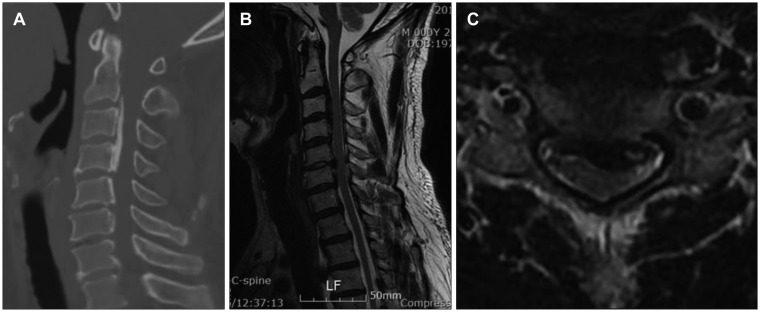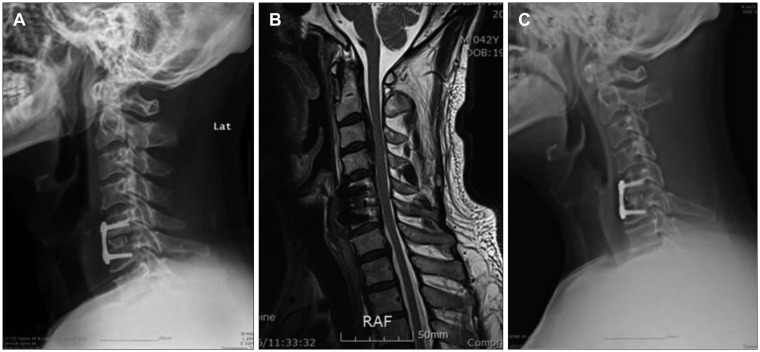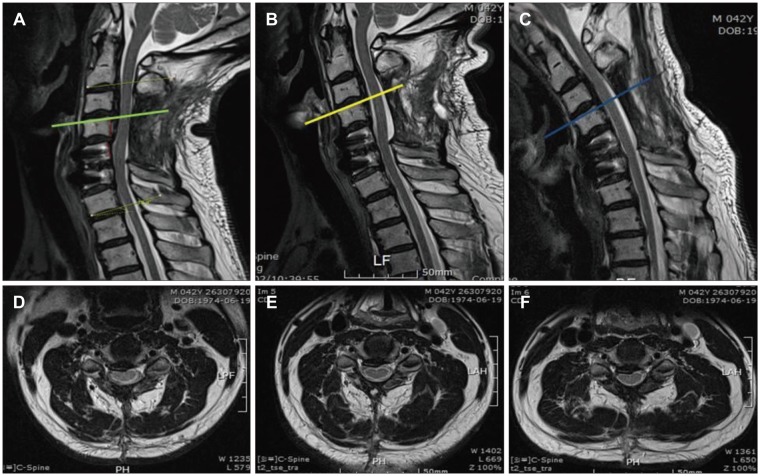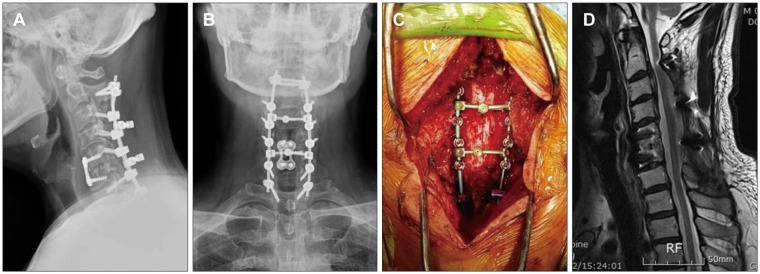Korean J Neurotrauma.
2018 Oct;14(2):164-168. 10.13004/kjnt.2018.14.2.164.
Investigation of Symptomatic Unstable Changes of Non-Fused Component in the Mixed-Type Cervical Ossification of Posterior Longitudinal Ligament Using Dynamic Magnetic Resonance Imaging: A Case Report
- Affiliations
-
- 1Department of Neurosurgery, Yeungnam University Medical Center, Yeungnam University College of Medicine, Daegu, Korea. jicns@ynu.ac.kr
- KMID: 2424333
- DOI: http://doi.org/10.13004/kjnt.2018.14.2.164
Abstract
- A 43-year-old man was transferred to our hospital with recurring myelopathic symptoms after previous anterior and posterior surgical decompressions for mixed-type cervical ossification of the posterior longitudinal ligament (OPLL). Conventional magnetic resonance imaging (MRI) showed a preserved cervical curve and the achievement of successful decompression after the previous surgeries. The patient's symptoms were aggravated when he was in the extended neck posture. Dynamic MRI performed with the patient in an extended neck position revealed cord compression by OPLL from C3 to C4 with newly developed retrolisthesis of the C4-5 segment. We recommend the use of dynamic MRI to investigate motion-dependent cord compression caused by instability of the non-fused OPLL component.
MeSH Terms
Figure
Reference
-
1. An HS, Al-Shihabi L, Kurd M. Surgical treatment for ossification of the posterior longitudinal ligament in the cervical spine. J Am Acad Orthop Surg. 2014; 22:420–429. PMID: 24966248.
Article2. Chiba K, Yamamoto I, Hirabayashi H, Iwasaki M, Goto H, Yonenobu K, et al. Multicenter study investigating the postoperative progression of ossification of the posterior longitudinal ligament in the cervical spine: a new computer-assisted measurement. J Neurosurg Spine. 2005; 3:17–23. PMID: 16122017.
Article3. Dalbayrak S, Yaman O, Firidin MN, Yilmaz T, Yilmaz M. The contribution of cervical dynamic magnetic resonance imaging to the surgical treatment of cervical spondylotic myelopathy. Turk Neurosurg. 2015; 25:36–42. PMID: 25640543.4. Evans LT, Lollis SS. Dynamic compression of the spinal cord by paraspinal muscles following cervical laminectomy: Diagnosis using flexion-extension MRI. Case Rep Radiol. 2015; 2015:275623. PMID: 25984378.
Article5. Jeon I, Cho YE. Analysis of factors contributing to repeat surgery in multi-segments cervical ossification of posterior longitudinal ligament. J Korean Neurosurg Soc. 2018; 61:224–232. PMID: 29526066.
Article6. Kawaguchi Y, Kanamori M, Ishihara H, Nakamura H, Sugimori K, Tsuji H, et al. Progression of ossification of the posterior longitudinal ligament following en bloc cervical laminoplasty. J Bone Joint Surg Am. 2001; 83-A:1798–1802. PMID: 11741057.
Article7. Lee DH, Cho JH, Kim NH, Kim S, Choi J, Hwang CJ, et al. Radiological risk factors for progression of ossification of posterior longitudinal ligament following laminoplasty. Spine J. 2018; 18:1116–1121. PMID: 29126953.
Article8. Sheen JJ, Jeon SR. Midline splitting cervical laminoplasty using allogeneic bone spacers: Comparison of fusion rates between cervical spondylotic myelopathy and ossification of posterior longitudinal ligament. Korean J Neurotrauma. 2014; 10:60–65. PMID: 27169035.
Article9. Smith ZA, Buchanan CC, Raphael D, Khoo LT. Ossification of the posterior longitudinal ligament: pathogenesis, management, and current surgical approaches. A review. Neurosurg Focus. 2011; 30:E10.
- Full Text Links
- Actions
-
Cited
- CITED
-
- Close
- Share
- Similar articles
-
- Cervical Ossification of Posterior Longitudinal Ligament in X-Linked Hypophosphatemic Rickets Revealing Homogeneously Increased Vertebral Bone Density
- Ossification of the Posterior Longitudinal Ligament: 2 cases report
- Dysphagia Caused by Ossification of the Cervical Anterior Longitudinal Ligament
- Ossification of Posterior Longitudinal Ligament(OPLL) of Cervical Spine
- Cervical Spine CT and MRI Findings in a Patient with Ossification of the Posterior Longitudinal Ligament





